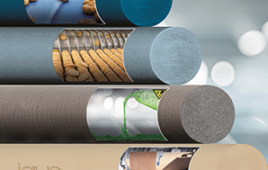What are the differences between biodegradable and biobased plastics?
The demand for bioplastics has increased dramatically over the last few years, but there still tends to be a lot of confusion about the terms used in environmental claims. Bioplastics are often labeled one, or a combination, of biobased, biodegradable or compostable. What do these labels mean and how are they different from each other?
What are biobased plastics?
Biobased plastics are made from renewable resources instead of non-renewable petroleum based resources. These renewable resources can include corn, potatoes, rice, soy, sugarcane, wheat, and vegetable oil. This involves a process of creating plastic polymers from these materials, through either chemical or biological processes. Examples of these types of plastics include polylactic acid (PLA) which is derived from starch, polyhydroxybutyrate (PHB) which is derived through microbial synthesis, and biobased polyethylene (bioPE), which is produced from sugar cane.
In the United States, the USDA Biopreferred Program promotes products with renewable content by certifying them as biobased. The program uses ASTM’s D6866 standard for measuring the percentage of biobased content by measuring the presence of Carbon-14 in the material. Since Carbon-14 is absorbed by plants while they are alive and decays over a few thousand years, the test can differentiate between renewably sourced materials and carbon compounds sourced from long-dead, non-renewable petroleum.
Advantages
- Using biobased materials reduces reliance on non-renewable petroleum-based feedstocks
- Keeping fossil carbon in the ground can help to reduce greenhouse gases by up to 35 percent1
- Using plant-based feedstocks increases the value of agricultural byproducts, creating another revenue stream for farmers and rural economies
- While traditionally used in single-use products, new technology and designs allow for durable goods
While biobased materials can be biodegradable or compostable, not all of them are. Just as important, not all biodegradable plastics are biobased.
What are biodegradable plastics?
Biodegradable plastic degrades through exposure to naturally occurring microorganisms. When classifying a plastic as a biodegradable, the environment and timeframe must be specified; otherwise the claim is rendered pointless due to an array of variations. All organic matter will eventually biodegrade. This includes traditional petroleum-based plastics. However, the rate of biodegradation of different organic materials can vary on an exponential scale.
The plastics we call “biodegradable” are designed to biodegrade in specific environments, including marine environments, sunlight, soil, industrial composting facilities and backyard home compost.
In the U.S., plastics labeled “compostable” are designed to degrade in an industrial composting environment at a similar rate to other known compostable materials without leaving visual or toxic residue. To qualify as compostable, the plastic is tested according to ASTM’s D6400 test protocols. In this test, plastic is placed in a controlled composting test and must disintegrate to no more than 10 percent of the original dry weight after 84 days. In addition, 90 percent of the organic carbon must convert to carbon dioxide within 180 days, and contain less than 50 percent of the maximum allowable concentrations of certain heavy metals. Once processed, the finished compost must be able to support germination of two different plant species at a rate of 90 percent in a control sample. European agencies have created standards for home composting as well; however, at the time of this writing, these standards have not been adopted by the American Society for Testing and Materials (ASTM).
Designers should note that just because a compostable material is used for a product doesn’t mean the product will meet these standards. A product’s actual rate of degradation will vary depending upon its thickness.
Advantages
- Biodegradable materials are ideal for packaging and single-use applications
- Use of these materials increases productivity in horticultural applications
- Reduces plastic litter in marine environments
- Has the potential to reduce the amount of organic material going to landfills
What are the best applications for biobased materials and biodegradable plastic?
Traditionally, biobased plastics’ primary applications were single-use items — plastic bottles, utensils, etc. Recently, companies have developed better performing biobased materials that are suitable for a wider range of durable applications. As a result, growing amounts of biomaterials are finding their way into mainstream products ranging from automotive and furniture to construction and toys.
Compostable plastics have seen the most use in packaging, food service ware and agricultural mulch films. Since utensils, plates and containers made from compostable plastics can be discarded and composted along with the food waste, they reduce the amount of material going to landfills. Agricultural mulch films used to cover seedlings decrease water, herbicide and pesticide use. Using biodegradable materials eliminates the cost of removing and disposing of the film at the end of the growing season.
While biobased materials and biodegradable plastics have many differences in composition, development and usage, they can offer distinct advantages over traditional petroleum-based plastics. With more consumers looking for greener products, biobased and biodegradable plastics are becoming an ideal solution for product designers and plastics processors seeking to lighten the environmental footprint of the products we use every day.
Author Bio – Kevin Ireland is the Communications Manager for Green Dot Bioplastics, a Kansas-based manufacturer of bioplastics and biocomposites. Green Dot provides OEM, plastics processors and designers with materials to meet the growing demand for more sustainable plastic. The company offers a wide range of biobased and biodegradable formulations customized to customer specifications. To learn more, please visit www.greendotbioplastics.com.
1 Plant-based Plastic Packaging Market – An Insight on the Important Factors and Trends Influencing the Market, Transparency Market Research, 2017
Filed Under: Materials • advanced




